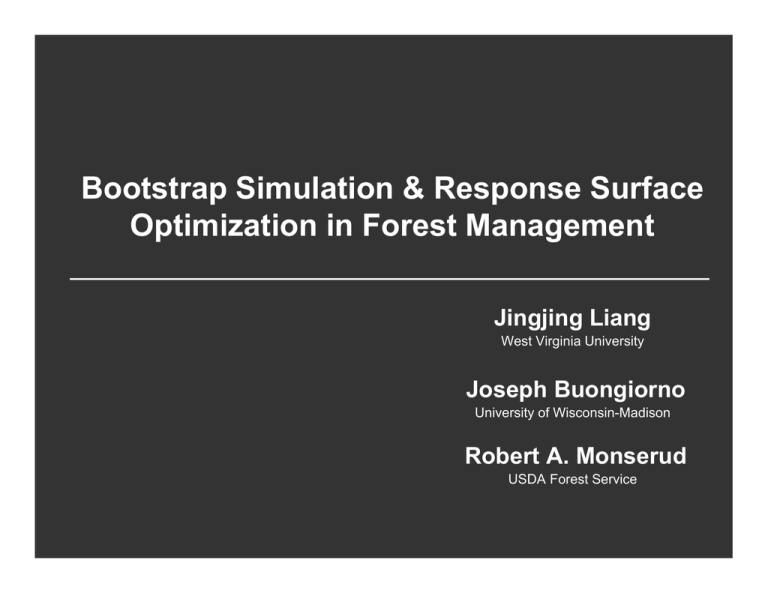Bootstrap Simulation & Response Surface Optimization in Forest Management Jingjing Liang Joseph Buongiorno
advertisement

Bootstrap Simulation & Response Surface Optimization in Forest Management Jingjing Liang West Virginia University Joseph Buongiorno University of Wisconsin-Madison Robert A. Monserud USDA Forest Service What is the BEST- • target stand distribution • cutting cycle • target stand basal area • financial return for • wood quality ? • ecology 2 Models Involved • forest growth stand growth model stumpage price model • financial return interest rate model • wood quality log grade model • ecology Shannon’s diversity 3 Stand growth model 100 100 Douglas-fir Trees/ha 60 40 80 Trees/ha Predicted, DF Model Predicted, FVS Observed 80 20 60 40 20 0 0 0 10 20 100 30 40 50 60 70 Diameter (cm) 80 90 100 110 0 10 20 30 100 Other shade-intolerant 40 50 60 70 Diameter (cm) 80 90 100 110 90 100 110 Other shade-tolerant 80 Trees/ha 80 Trees/ha Western hemlock 60 40 60 40 20 20 0 0 0 10 20 30 40 50 60 Diameter (cm) 70 80 90 100 110 0 10 20 30 40 50 60 70 80 Diameter (cm) Liang, Buongiorno, Monserud. 2005. Growth and Yield of All-aged Douglas-fir/western hemlock Stands: A 4 Matrix Model with Stand Diversity Effects. Can. J. For. Res. 35: 2369-2382. Stand growth model et 1 y t 1 y t 1 y t 1 G y t y t R y t u t 1 Bootstrapped from 60 60 Douglas-fir 40 30 20 10 0 40 30 20 10 0 0 30 60 90 120 60 150 0 30 60 A Year 90 120 60 Other shade-intolerant species 150 B Year Other shade-tolerant species 50 Basal area (m2/ha) 50 Basal area (m2/ha) Western hemlock 50 Basal area (m2/ha) Basal area (m2/ha) 50 40 30 20 10 0 40 30 20 10 0 0 30 60 90 Year 120 150 C 0 30 60 90 Year 120 150 D 5 Stumpage price model Stumpage price ($/m3) 800 600 400 200 0 1977 1979 1981 1983 1985 1987 1989 1991 1993 1995 1997 1999 2001 2003 Year Oregon Quarterly stumpage prices of Douglas-fir Grade I logs Pt 1 0.6Pt 0.9et et 1 6 Interest rate model 10 Interest rate 8 6 4 2 0 -2 1977 1979 1981 1983 1985 1987 1989 1991 1993 1995 1997 1999 2001 Year Interest rate in real term of AAA bonds rt 1 0.72 0.81 rt t 1 7 Log grade model I: peeler II: #1 sawmill III: #2 sawmill Dependent variable ln l l 0 l1 D l 2 S m Coefficient Douglas fir π1/ π4 IV: #3 sawmill V: other grades Independent variable π3/ π4 Constant 2.91 * D 0.04 ** S -0.10 ** Constant 1.66 D 0.04 ** S -0.10 * Constant -8.94 * D 0.41 ** S -0.40 * Constant -8.37 * D 0.35 ** S -0.30 * Constant -5.90 ** D 0.26 ** S -0.13 ** Western hemlock π1/ π4 π2/ π4 π3/ π4 8 Bootstrap simulation Bootstrapped random shock stand growth model stand growth model stumpage price model stumpage price model interest rate model interest rate model a demonstration of Bootstrap procedure 9 Measure of performance • land expectation value LEV W vh w (1 r ) w w0 vy 50 (1 r ) 50 vy 0 • percentage of peeler logs in stock • species/size diversity Bi Bi H s ln B i 1 B m 10 Simulation parameters • target stand distribution: BDq selection method • Basal area: 60, 120, 180, 240, 300 (ft2/ac) • Diameter: 40 • q-ratio: 1.2, 1.4, 1.6, 1.8 (in.) • cutting cycle: 10, 15, 20, 25, 30 (yr) • timespan: 50 (yr) 11 Initial stand distribution 500 plots bootstrapped from the 2,706 initial Douglas-fir/western hemlock plots in the Pacific Northwest 9 Annual production (m3 /ha/y) 25 NPV ($1000/ha ) 20 15 10 5 7 6 0 100 200 300 400 500 600 0 100 A Number of plots 200 300 400 500 600 B Number of plots 1.18 Average basal area (m 2/ha) 27 1.17 Species diversity 8 1.16 1.15 1.14 1.13 26 25 24 23 0 100 200 300 400 500 600 0 100 C Number of plots 200 300 400 500 600 D Number of plots 42 2.48 Percentage of peeler Size diversity 41 2.46 2.44 2.42 40 39 38 37 0 100 200 300 400 Number of plots 500 600 E 0 100 200 300 400 Number of plots 500 600 F F 12 Response surface • • • basal area: q-ratio: cutting cycle: 60, 120, 180, 240, 300 (ft2/ac) 1.2, 1.4, 1.6, 1.8 10, 15, 20, 25, 30 (yr) 5×4×5=100 management alternatives response surface equations R2 Equation P=71.20** -1.61**C +0.21B -26.63**q +0.029C2 2.10B2 +5.62**q2 -0.32CB -2.08Bq +1.09**Cq 0.97 0 -2 -4 -6 -8 Hs=1.35** +0.012C -0.15**B -0.05q +0.0005C2 +0.11**B2 +0.02q2 -0.005CB -0.09**Bq -0.02**Cq 0.98 -10 -12 2 -2 1 -1 0 0 -1 1 -2 -0.005C2 Hd=3.24** -0.12**C -0.09B -0.23**q 2 2 0.03B -0.16**q -0.01CB +0.07Bq +0.11**Cq 2 0.99 13 Optimization Management criterion Maximum Control variable Cutting cycle (year) Basal area (m2ha-1) Target q ratio Land expectation value (1000$ha-1) 8.20 10 51 1.8 Annual Production (m3ha-1y-1) 9.00 10 51 1.8 Species diversity 1.27 10 14 1.2 Size diversity 2.74 10 14 1.2 Percentage of peeler logs 46.7 10 14 1.2 Stand basal area (m2ha-1) 28.3 30 51 1.7 14 LEV Sensitivity analysis 10 10 10 5 5 5 0 0 0 -5 -5 P 10 15 20 C (yr) 25 30 -5 10 20 30 B (m 2/ha) 40 50 1.2 46 46 44 44 44 42 42 42 40 10 15 20 C (yr) 25 30 1.6 1.8 1.6 1.8 1.6 1.8 1.6 1.8 q 46 40 1.4 40 10 20 30 B (m 2/ha) 40 50 1.2 1.4 q 1.26 1.26 1.24 1.24 1.24 1.22 1.22 1.22 Hs 1.26 1.2 1.2 Hd 10 15 20 C (yr) 25 30 1.2 10 20 30 B (m 2/ha) 40 50 1.2 q 2.8 2.8 2.8 2.7 2.7 2.7 2.6 2.6 2.6 2.5 2.5 2.5 2.4 2.4 10 15 20 C (yr) 25 30 1.4 2.4 10 20 30 B (m 2/ha) 40 50 1.2 1.4 q 15 10 10 5 5 LEV($1000/ha) LEV($1000/ha) Inter-criterion correlation 0 -5 -10 0 -5 -10 2 4 6 8 10 39 Annual production (m 3/ha/y) 48 50 Percentage of peeler Percentage of peeler 45 Percentage of peeler 50 47 44 41 38 1.14 42 1.16 1.18 1.20 1.22 1.24 Species diversity 1.26 1.28 47 44 41 38 2.37 2.47 2.57 2.67 2.77 Size diversity 16 Summary of study • Bootstrap simulation • Response Surface optimization • Adjusting B, q, and C could control for more than 97% of the variability in species and size diversity, percentage of peeler logs, and basal area, but could control for less in LEV and annual production. • Strong positive correlation between LEV and annual production, and between wood quality and size diversity • negative correlation between LEV and wood quality. 17 Acknowledgement Jingjing Liang jiliang@mail.wvu.edu 304-293-1577 The research leading to this paper was supported in part by the USDA Forest Service, Pacific Northwest Forest Research Station, Human and Natural Resources Interaction Program, NRICGP grant 2001-35108-10673, and by the School of Natural Resources, University of Wisconsin-Madison. We thank Dean Parry, Karen Waddell, and Susan Stevens Hummel for assistance with the data. 18






